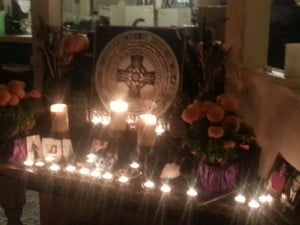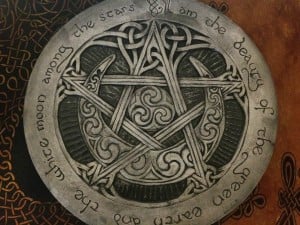In many ways, the most convincing evidence supporting the definition of Pagan religion that I have discussed in this series is traditional Pagan peoples’ reactions when they meet modern NeoPagans in interfaith work.
A few years back it was trendy in some Religious Studies circles to argue that NeoPagans were so different from indigenous and African Diasporic religions that we should not all be lumped together as “Pagan.” Enmeshed within theoretical categories decisively shaped by secular academic culture, and with next to no contact with wider Pagan communities, these scholars theorized about what they did not understand. Had they taken the time to interact with different kinds of Pagans, they would have been far more tentative in their pronouncements, or perhaps not made them at all.
Wiccans were the first NeoPagans to become involved in interfaith work, and of course the popular term for Wiccans was “witches.” In an interfaith context, initially indigenous Pagans were sometimes doubtful about our spiritual affinities because of what they had heard about “witches” from Christian sources. This term “witch” alarmed traditional Pagans because for years they had been taught that witchcraft was bad and witchcraft was the practice of baneful magick. To complicate matters, their indigenous traditions had also been labeled witchcraft.
Indigenous Pagans knew that baneful magick existed, and so had no problem applying the English word “witchcraft” to it. Why not? But they also knew that they did not practice baneful magick and so, despite what the church and missionaries claimed, they were not witches. What then to make of Westerners who described themselves as witches? Were they not practitioners of baneful magick? It took many conversations to clear up these problems rooted in the Christian domination and distortion of language. But they have been cleared up.
In religious terms, over a thousand years of Christian domination powerfully shaped how most Europeans talked and thought about religion. As Christianity was imposed elsewhere these terms were used again to describe Pagan practices abroad and justify their destruction. It became difficult to think clearly outside of Christian categories. Christian missionaries argued that their physical power was evidence of their spiritual power. They and their allies in government used physical violence to slaughter or incarcerate those who opposed them religiously, and often to seize their children from their parents for indoctrination. If they survived the experience, the children returned deeply confused or brainwashed about their ancestral beliefs. Many indigenous traditions were shattered, and those that remained were insecure and often driven underground. (I once helped build a Sun Dance arbor on the Crow Reservation in Montana, and I talked with Crow elders who described having to practice the Sun Dance in secret because it was illegal, despite the First Amendment.) Many could not help but wonder, “What if the Christians were right?”
The best description I have encountered of how all this impacted many Pagan peoples is in Kent Nerburn’s The Girl Who Sang to the Buffalo. An old Lakota man says:
“It did not take many lifetimes to lose touch with [our] ways. You took away our language, and our connection with the plants and animals lives in our language. You moved us from our land, and we met the Creator in the land. Our way of thinking changed, and we lost touch with the old power. Maybe we forgot and it’s still there. I only know now that its now only a ghost living inside me. It’s like the echo of a sound I can no longer remember.” (264) […]
“[Y]ou don’t know what its like to live with two worlds inside you.” (266)
In interfaith gatherings, surviving indigenous Pagans met moderns who were also beginning to have two worlds living inside us, but coming from the other direction. This mutual recognition benefits us both, and many in both groups recognize it is so.
Once indigenous practitioners learned what Wiccans were about, they came to see us as allies, as spiritual brothers and sisters, as kindred spirits. One unanticipated benefit for them was to demonstrate conclusively that theirs was not a ‘primitive’ religion unsuitable for the modern world because here were modern computer savvy educated Americans and Europeans practicing recognizable variants of what they themselves did, and rejecting the Christian story. In addition, as they met people from other continents they could see their commonalities, and so helped remove the sense of isolation that afflicts the powerless and keeps them vulnerable.
We benefited as well, learning we were the most recent expression of the world’s most primordial religious tradition. We found ourselves within a context that gave our religion depths of meaning and connection we had not often been aware of. We were not just one of the more exotic manifestations of American culture, a flash in the cultural pan like bell bottoms and pet rocks.
How much was the same between us? Quite a lot. For example, when Don Frew wrote an interfaith document about Pagan religion, he was criticized by some who rejected the claim thatPagans recognize both a world of individuated spirits and an ultimate context. Frew replied:
I have discussed the ideas in my article at great length with Shinto priests from Japan & the US, Hindu priests from India & the US, African shamans from several sub-Saharan countries, a Maori Elder Council spokesperson from New Zealand, a Taoist priest in the US, an Aymara shaman from Bolivia, a Maya priest from Guatemala, tribal elders from across Latin & North America, revered teachers of Chinese folk religion from Taiwan & Hong Kong, Afro-diasporic spiritual leaders from Brazil & Nigeria, and many more. Every single one of these teachers believed that the Gods & Goddess (by whatever names were used in their traditions) were our most direct link to the spiritual unity that underlies everything.
I personally know this to be true for some Native Americans and members of Brazilian and African Diasporic tradition with whom I have dealt, none of whom were included in Frew’s statement. For example, I was surprised at how “at home” I felt in a Voudon Circle in New Orleans, where I was a guest many years ago. Despite the different atmosphere of drumming and incorporation of the Loa, energetically it felt very much like a good Wiccan circle. (This was a small group. Bigger than a coven, but not by a lot.)
Earlier in the day I had driven to her botanica to introduce myself to the group’s priestess, who had generously invited me to visit her ceremony. We had an opportunity to talk at length. She told me at one point her own teacher had studied Wicca, before deciding Voudon met his spiritual needs better than the alternative paths he explored. Our conversation was very much like NeoPagans in different traditions amicably discussing these matters with one another with mutual respect. I enjoyed it immensely. I hope she did.
There is probably no more numerous polytheistic tradition alive today than those within the African diaspora. In Voudon Damballah is the father of all the Loa. In Santeria, a related tradition in the Spanish speaking world, the father of all Orishas is Obatala, but he is the conduit to Olodumare, the source of all. It is no different in Umbanda, Candomble, or any other African diasporic tradition of which I know.
In an earlier post I described my interactions with a Naxi priest from Northwest China. Again, we felt at home in one another’s rituals and appreciated some of the similarities as well as differences between them. I believed, and he seemed to as well, that the similarities were deeper than the differences.
In large interfaith gatherings, Pagans from many traditions and cultures find themselves drawn to one another in a process of self-selection. We feel comfortable together. Interfaith also provides a context where we can see where we are similar and where we differ from friendly practitioners of other paths, those who are drawn to different stories but open to respecting others’. Over time, the Pagan traditions have naturally come to gather together under the “Pagan” label, drawn by our common attraction to the Pagan story. It is win-win all the way down.
The definition of Paganism I gave in 2000, which is independently described by others such as Christine Kraemer, has at least three interlocking reasons for being taken seriously: logical coherence such that other careful scholars are led to finding the same pattern, historical continuity across thousands of years, and mutual recognition within Pagan communities of many different cultures. The story’s coherence helps to hold together the many cultures spread across thousands of years and miles, providing a common core that is explored in many different ways.
We are one of the world’s great religious traditions and by far its oldest. We should take deep satisfaction and pleasure in that fact.
















